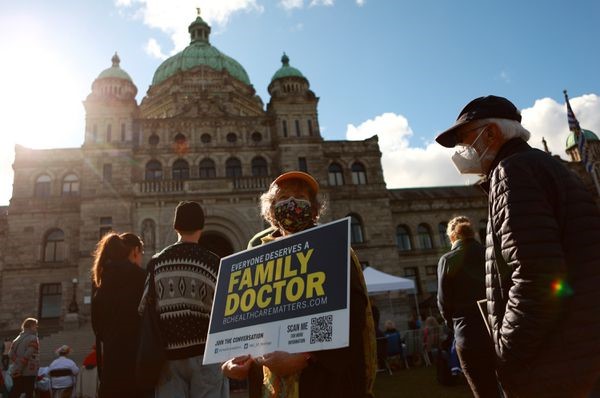The medical clinic in Greater Victoria doesn’t open its doors until 8 o’clock, but two dozen people were already lined up outside in the predawn chill on a recent October morning. Reg Green, the first person in line, had been there since 5:45 a.m. He needed a doctor to review his blood pressure medication and didn’t want to lose a day’s work at his window cleaning business. The first time he went to the Westshore Urgent Primary Care Centre two weeks earlier, he said, he waited more than four hours to get a shoulder injury examined. This time, he got up extra early. “I was out of there by 8:30, so that’s all right.”
Mr. Green says he has been searching for a family doctor since his “flew the coop” four years ago and moved back to England. Finding a doctor in Victoria who is taking new patients is just about impossible. Only one clinic in the entire city has openings, Beta Therapeutics, according to the website FindaDoctorBC.ca. Its sole family doctor began charging patients a monthly fee of $110 for his services on Nov. 1, which has alarmed proponents of public health care.
With nearly no options, a growing number of people in the B.C. capital rely instead on walk-in medical clinics and long delays have become a staple of their care. In 2021, Victoria patients waited two hours and 41 minutes on average to see a doctor – the longest of any city in Canada, says a study by Medimap, a technology company that partners with about 1,200 clinics across the country to provide updates on waiting times.
Based on the numbers alone, Victoria seems to have all the family doctors it needs, with nearly three times more than the national average. Across Canada, the country has more family doctors than ever before – 47,337 in 2021, up 24 per cent from a decade earlier and increasing more than twice as fast as the national population over the same period, show figures from the Canadian Institute for Health Information (CIHI).
| Year | Number of family doctors | Population |
| 1971-01-01 | 13692 | 21962.03 |
| 1972-01-01 | 14292 | 22218.46 |
| 1973-01-01 | 14906 | 22491.78 |
| 1974-01-01 | 15531 | 22807.97 |
| 1975-01-01 | 16362 | 23143.28 |
| 1976-01-01 | 17021 | 23449.81 |
| 1977-01-01 | 17638 | 23725.84 |
| 1978-01-01 | 17897 | 23963.2 |
| 1979-01-01 | 18453 | 24201.54 |
| 1980-01-01 | 18838 | 24515.67 |
| 1981-01-01 | 19217 | 24819.92 |
| 1982-01-01 | 20338 | 25116.94 |
| 1983-01-01 | 21126 | 25366.45 |
| 1984-01-01 | 21579 | 25607.05 |
| 1985-01-01 | 22768 | 25842.12 |
| 1986-01-01 | 23514 | 26100.28 |
| 1987-01-01 | 24749 | 26446.6 |
| 1988-01-01 | 26046 | 26791.75 |
| 1989-01-01 | 27130 | 27276.78 |
| 1990-01-01 | 27293 | 27691.14 |
| 1991-01-01 | 27868 | 28037.42 |
| 1992-01-01 | 28406 | 28371.26 |
| 1993-01-01 | 29302 | 28684.76 |
| 1994-01-01 | 28668 | 29000.66 |
| 1995-01-01 | 28588 | 29302.31 |
| 1996-01-01 | 28199 | 29610.22 |
| 1997-01-01 | 28092 | 29905.95 |
| 1998-01-01 | 28519 | 30155.17 |
| 1999-01-01 | 28784 | 30401.29 |
| 2000-01-01 | 29113 | 30685.73 |
| 2001-01-01 | 29627 | 31020.9 |
| 2002-01-01 | 30258 | 31360.08 |
| 2003-01-01 | 30662 | 31644.03 |
| 2004-01-01 | 31094 | 31940.66 |
| 2005-01-01 | 31633 | 32243.75 |
| 2006-01-01 | 31989 | 32571.17 |
| 2007-01-01 | 32598 | 32889.03 |
| 2008-01-01 | 33712 | 33247.12 |
| 2009-01-01 | 34793 | 33628.9 |
| 2010-01-01 | 35366 | 34004.89 |
| 2011-01-01 | 36769 | 34339.33 |
| 2012-01-01 | 38156 | 34714.22 |
| 2013-01-01 | 39392 | 35082.95 |
| 2014-01-01 | 40781 | 35437.44 |
| 2015-01-01 | 41551 | 35702.91 |
| 2016-01-01 | 42522 | 36109.49 |
| 2017-01-01 | 44191 | 36545.24 |
| 2018-01-01 | 45450 | 37065.08 |
| 2019-01-01 | 46131 | 37601.23 |
| 2020-01-01 | 46797 | 38037.2 |
| 2021-01-01 | 47337 | 38246.11 |
But those figures reflect only the number of licensed family doctors, not where and how they work. A simple headcount doesn’t capture how many hours family doctors are working, or how many are dividing their time between office-based primary care and practising in hospitals, nursing homes, walk-in clinics or sports medicine clinics.
These significant gaps in data mean Canadians don’t know the true capacity of primary care in Victoria or anywhere else in the country, and that lack of information is hindering the provinces’ ability to deal with a growing crisis.
Access to primary care is getting worse in many parts of the country, according to statistics collected by The Globe and Mail and interviews with dozens of medical experts and patients.
The mismatch between the numbers on paper and what is actually happening on the ground reflects a broader problem plaguing Canada’s health care system.
The country will continue to lack that data for the foreseeable future. This month, provinces and the federal government came to an impasse in discussions about funding a pan-Canadian health data system, which would have tracked health workers and defined the tasks performed by family doctors.
“Part of the reason why we are where we are right now is that we haven’t been able to do proper health human resource planning,” said Tara Kiran, a family physician and researcher at the University of Toronto’s Department of Family and Community Medicine. “We lack the data to do that. And we haven’t understood how people are practising in real life.”





